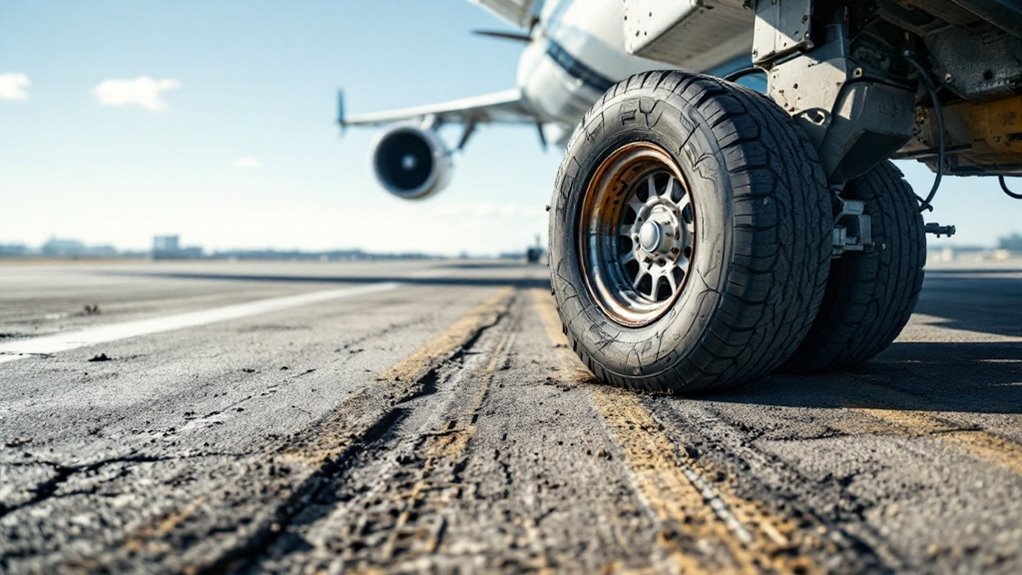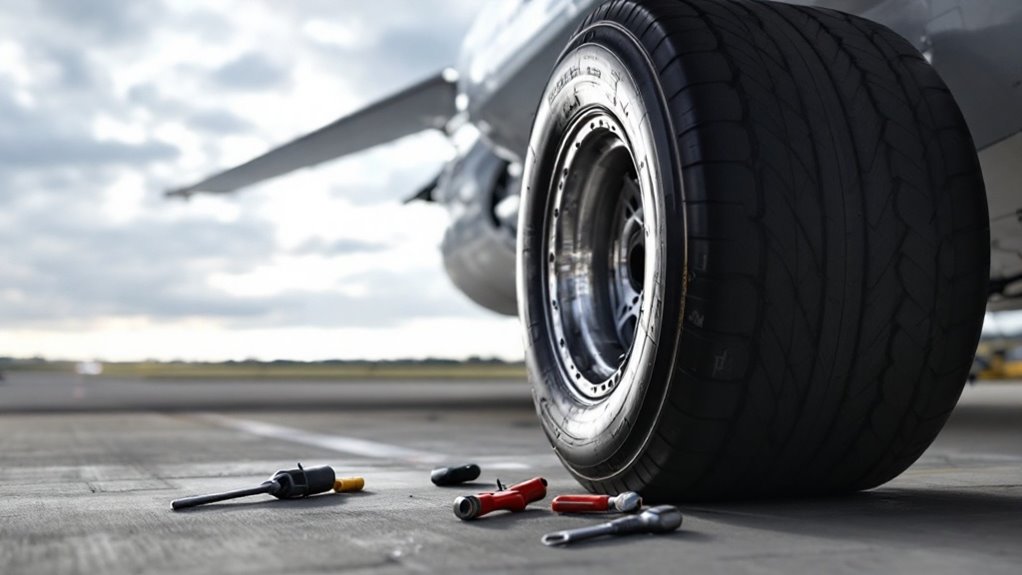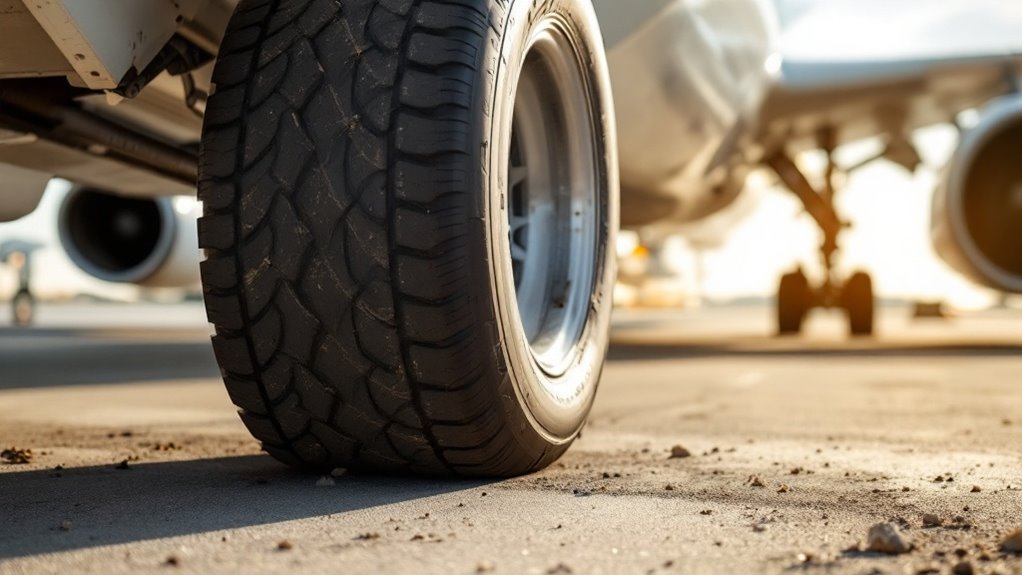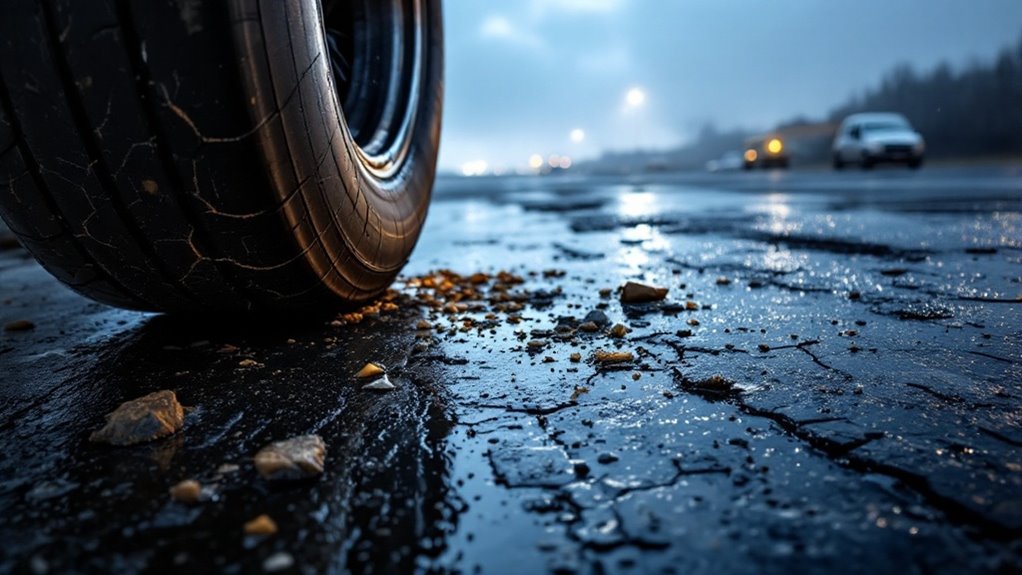How Often Do Airplanes Change Tires
This post contains affiliate links. As an Amazon Associate, we earn from qualifying purchases.
Airplanes swap their tires pretty often, usually every 150 to 400 landings. The exact number depends on the plane type and how it’s used. Regional jets often need new tires after just 150 flights. Why? They take off a lot. Bigger widebody planes can go up to 400 landings. Rough landings and bad weather make tires wear out faster. Taxiing on runways also adds extra stress to them. Crews check tires all the time for safety. They look at tread depth and any damage. Stay with us to learn even more cool facts!
Essential Facts in 30 Seconds
- Airplane tires are generally replaced after 150 to 400 landings, varying by aircraft type.
- Main-wheel tires endure 300 to 450 landings, while nose-wheel tires last 200 to 350 landings.
- Regional jets require tire changes after about 150 flights due to frequent landings.
- Freighter aircraft need new tires after 150 to 200 flights because of heavy wear.
- Business jets can exceed 400 flights before tire replacement, thanks to lighter loads and gentler landings.
Factors Affecting Tire Wear in Airplanes
Tire wear in airplanes comes from many things.
Think about takeoff first. It causes big wear with heavy loads and friction.
Landings also stress tires with hard hits and heat.
Taxiing adds more damage too. Moving slow on the ground wears tires bit by bit.
Some machines make this worse. Bad air pressure in tires twists the tread. This can create tiny cracks over time. Underinflation, often by more than 10%, can cause internal tire damage.
Hot weather hurts tires as well. Temperatures over 25°C weaken the material. Nylon parts inside get hot, near 200°C. This risks breaking the tire completely.
Check this quick list for clarity:
- Takeoff: Heavy load, lots of friction.
- Landings: Big impact, extra heat.
- Taxiing: Slow, constant wear.
Pay attention to these points. Keep tires safe and strong. Good care means better flights!
Typical Lifespan of Aircraft Tires

Ever wonder how long aircraft tires last? They usually handle 150 to 400 landings. This depends on the aircraft type and conditions.
Main-wheel tires often last 300 to 450 landings. Nose-wheel tires, due to steering, last 200 to 350.
Landings stress tires a lot, especially at touchdown. Wear shows through less tread or clear damage. Spot these signs early for safety.
Maintenance logs track every detail. Stay safe by checking tires often! Additionally, the actual lifespan often reaches only about 70% of theoretical durability.
Average Tire Durability
Aircraft tire durability matters a lot for safe flying. It changes based on many things.
Main-wheel tires on big planes last for 300 to 450 landings. Nose-wheel tires face more wear and last 200 to 350 landings. Some tires, with good pressure, reach up to 600 landings. Others wear out after just 50 landings in tough conditions.
On average, tires work for 1,200 to 1,500 flight hours. Landings count more than hours for durability. Heavy planes and bad runways shorten tire life. Extreme weather, like hot or cold, affects tire pressure too. Nitrogen inflation helps by reducing moisture issues in tires.
Always check tires carefully to keep flights safe.
Landing Cycle Impact
Ever wonder why airplane tires wear out so fast? Let’s break it down!
Landing is tough on tires with huge forces at play. Imagine tires hitting the ground at over 150 knots. That’s a crazy speed jump in just one second! This creates massive stress on the rubber.
Planes can weigh over 200 tons. Tires carry this giant load every landing. They face intense heat and pressure too. These things shorten tire life a lot.
Check out what damages tires during landings:
- Speed Shock: Tires hit high speeds instantly and wear down fast.
- Heavy Load: They support up to 48 tons, testing their strength.
- Heat Damage: Hot and cold cycles weaken the tire material.
No surprise, tires only last 150 to 400 landings. That’s the hard truth!
Wear Threshold Indicators
Airplane tires face tough damage from hard landings. Let’s talk about measuring wear. Tires have special marks called wear threshold indicators. Think of them as tiny guides. They include ribs and grooves to check tire condition.
Experts use cool tools to measure rib heights. They compare old and new heights. This helps figure out wear speed. Quick checks stop big problems. Safety stays top priority.
Look at these key points often:
- Tread Depth: Keeps grip strong.
- Rib Height: Shows wear amount.
- Groove Shape: Tells if replacement is near.
Stay on top of checks. Fix tire wear fast. Safety always comes first.
Maintenance Practices for Tire Safety

Keep aircraft tires safe with regular checks. Look at them before every flight. Search for cuts, bulges, or stuck debris.
Do the same after landing too. During big maintenance, measure tread depth. Check sidewalls for cracks or damage. Replace tires if tread gets too thin.
Take out tires with defects right away. Foreign objects in tires are dangerous. Act fast to avoid big risks. Stick to strict rules for safety.
Use the right tools to inspect. Follow clear standards in your records. Stay alert to stop failures early. Tire safety keeps flights smooth always.
Routine Tire Inspections
Airplane tires need regular checks to stay safe and last long. Make tire inspections a top priority every day.
Check tire pressure after each flight or daily at least. Spot problems early to avoid big issues.
Focus on these key points during checks:
- Inflation Levels: Use a gauge to check tire pressure. Keep it above the lowest safe level. This stops risks from low pressure.
- Wear and Damage: Look at tread depth and tire condition. Use magnifying tools for a close look. Catch small cracks or wear fast.
- Foreign Object Damage (FOD): Do daily walks around the plane. Clear debris from the area. Small objects often harm tires.
Mandatory Replacement Criteria
Airplane tires face huge stress every day during flights. Safety rules are super strict for everyone. Always check tires for wear and damage. Replace them if tread wears down to the groove base.
Also, swap them if tread damage covers 1/8 of the circle. Act fast for cuts on the sidewall. Deep cuts to the outer layer mean replacement. Bulges from inside issues? Toss those tires right away.
Spot charred rubber from heat? That’s a danger sign. Scrap tires after hard takeoffs or fast landings too.
Here’s a simple list to remember:
- Wear: Tread hits groove base.
- Damage: Cuts or bulges on sidewall.
- Heat: Rubber looks burnt.
Stick to these tips for safe flights. Never skip checking for problems. Your careful eyes keep everyone safe!
Impact of Aircraft Type and Operations

Aircraft type and operations change how often tires need replacement. Different planes wear tires at different speeds. Why? Their design and use make a big difference. Let’s break it down simply.
Regional jets often need new tires after 150 flights. They land a lot on short trips. Widebody planes last longer, around 300 to 400 flights. Their weight spreads better, and long flights cut heat stress.
Now, let’s talk about operations and tire wear. Freighters wear tires fast, in 150 to 200 flights. Heavy loads and quick stops cause this.
Business jets do better, lasting over 400 flights. They’re lighter and land softly. Short-haul flights mean more landings per hour. This speeds up tire wear. Long-haul flights, though, are kinder to tires.
These details help plan maintenance with ease. Know your plane, know your needs!
Environmental and Runway Conditions

Let’s talk about something important for airplane tire care. Environmental and runway conditions matter a lot. They decide how often tires need replacement.
Think about weather, runway quality, and dirt around. Extreme heat or cold stresses tires badly. Runway junk like gravel can cut tires fast. That means quick fixes or new tires.
Humidity also plays a big role in tire wear. Wet air speeds up tire damage in hot places. Bad runways with rough surfaces wear tires out during landings.
Check these key problems:
- Busy airports mean more braking and tire stress.
- Deicing stuff in cold areas eats away tire material.
- Steep runway slopes put extra load on tires.
Do regular checks based on these issues. It keeps planes safe and saves time. Trust this to plan better tire care.
Advances in Tire Technology and Monitoring

Aviation is getting better with new tire tech and monitoring. These changes make planes safer and save money. Let’s dive into the cool stuff happening now!
Check out Michelin’s Air X Sky Light tires. They cut weight by 10-20%. Less weight means planes use less fuel. Plus, these tires last 10-20% longer. That’s more landings before a change!
Smart tires are a game-changer. They’ve sensors inside. These sensors check temperature, pressure, and wear instantly. Data goes straight to a system. Teams can predict problems before they happen. Isn’t that amazing?
Now, let’s break down the big wins.
First, real-time alerts. Sensors spot tire issues early. Ground crews fix them fast. Safety stays top-notch!
Second, smart maintenance. Data helps plan repairs better. No more guesswork. This cuts downtime and saves cash.
Third, stronger tires. New materials like Kevlar make them tough. Tires last much longer now.
Aviation keeps getting safer. Tech drives these awesome changes. You can trust these solutions!
Frequently Asked Questions
How Much Do Airplane Tires Cost?
Got questions about airplane tire costs? They range from $500 to $2,000 each. Think about that price! Maintenance matters too. Regular checks and retreading save money. These steps cut down expenses a lot. Stay on top of tire care. It really helps your budget!
Can Airplane Tires Be Recycled?
Airplane tires can indeed get a new life through recycling. Think of them turning into useful stuff! Many companies recycle these tires to cut down waste. They make mulch for playgrounds or fuel for industries. This process helps save our planet every day. Data shows millions of tires get reused yearly. Isn’t that amazing to know? Let’s keep supporting such eco-friendly steps!
Who Manufactures Airplane Tires?
Ever wondered who makes airplane tires? Big names like Michelin and Goodyear lead the way. They focus on top-notch technology. Their tires keep planes safe during flights. Trust me, they test everything! Over 500,000 tires get made yearly for planes. Safety is their main goal. Stick with these brands for quality!
Are Airplane Tires Ever Repaired?
Do airplane tires get fixed? Let’s find out the truth. Safety comes first in aviation. Tires face huge stress during takeoffs and landings. A small damage can cause big problems. So, airlines rarely repair tires. They replace them instead. Data shows most tires last only 200 to 300 landings. After that, new tires take over. This keeps everyone safe in the sky. Why take a risk? Replacing ensures no accidents happen. Trust me, safety isn’t worth gambling on. Airlines always choose caution over cost. That’s the smart way to fly.
How Are Old Tires Disposed Of?
Old tires need proper disposal to help the environment. Tire recycling plays a big role in this process. We shred tires and remove steel from them. Then, we turn rubber into small bits called crumb. These bits make new things like playground surfaces. This way, we avoid waste and stay sustainable. Did you know? Millions of tires get recycled each year. That saves a lot of space in landfills! So, recycling tires is a smart choice for everyone.
Conclusion
Airplanes need strong tires for safe flights. Think about those tires! They face tough runways every day. Airlines change tires after 120 to 400 landings. This depends on the plane and weather. Experts check tires often to keep you safe. Modern tools help spot problems early. Data shows strict care stops accidents. Trust the team behind each flight. They work hard for your safety. Every takeoff means careful checks are done. You can feel secure up there.
